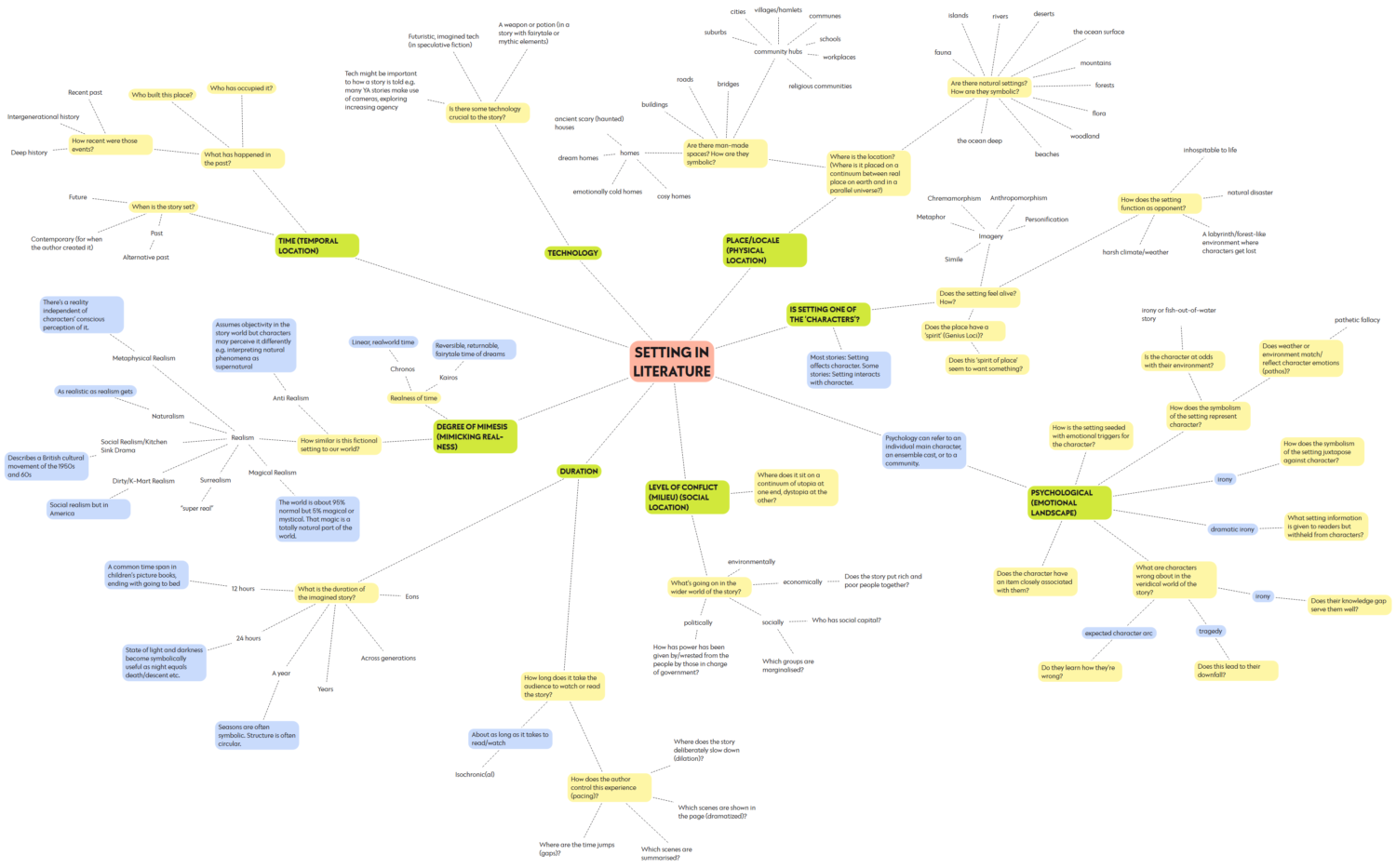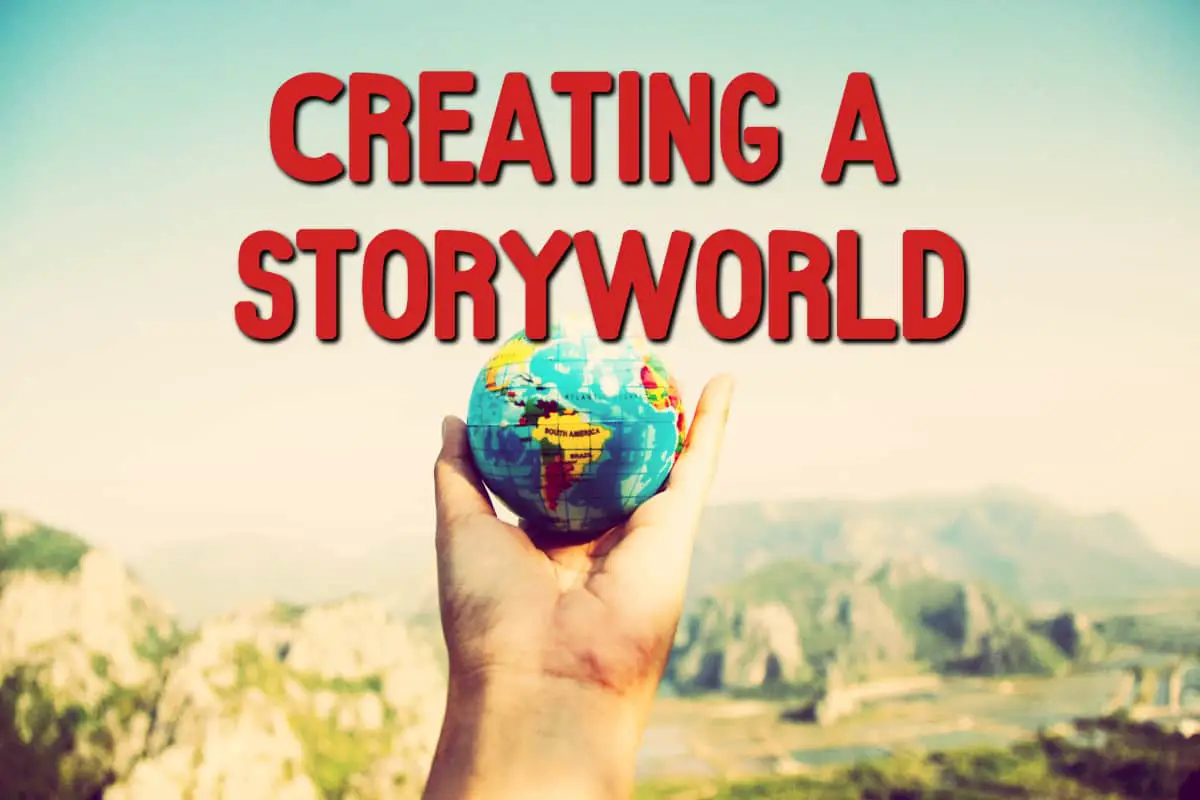In stories, setting and character are inextricably linked. Setting affects character. Sometimes, the setting can be treated like one of the characters.
What Is A Fictional Setting Made Of?
There are many ways to break Fictional Setting into a taxonomy. Here’s a mindmap showing how I think of it.

- PERIOD — a story’s place in time
- DURATION — a story’s length through time. Maybe it takes place over a year, cycling through each season. Maybe it takes place over 24 hours.
- LOCATION — a story’s place in space — On a scale: a real place, fictional but based on a real place, completely made up, otherworldly.
- ARENA — inside that location, there will be an ‘edge’ to your story, kind of like a computer game.
- MANMADE SPACES — buildings, roads, bridges, cities, villages, houses, etc
- NATURAL SETTINGS — deserts, rivers, mountains, islands, forests, beaches, etc
- WEATHER — This might rely on pathetic fallacy, e.g. the character is sad so it is raining. Or sunny weather might make a sad character feel even worse.
- TECHNOLOGY CRUCIAL TO THIS PARTICULAR STORY – There may or may not be some technology which your plot will rely on. In some genres (especially science fiction) this technology will be central.
- LEVEL OF CONFLICT — the story’s position on the hierarchy of human struggles. If ‘time and place’ refers to temporal and physical location, this refers to the social one. What’s going on in the wider world of the story, politically, socially, environmentally…? A ten dollar word to use here is ‘milieu’.
- THE EMOTIONAL LANDSCAPE — The land which lives inside the main character. The imaginative landscape, the difference between what is real in the veridical world of the story and how a character perceives it — never exactly as it is, but rather influenced by their own preconceptions, biases, desires and personal histories. In what way are characters wrong about the veridical world of the story, and how will this be their downfall (or advantage)?
Fictional Settings Are Specific But Also Universal
“People think that what happens to someone else has nothing to do with them. They think that what happens in one place doesn’t matter anyplace else.”
This reminded me of Czeslaw Milosz: If a thing exists in one place, it will exist everywhere.
Carolyn Forche
How To Make A Setting Come Alive
The Chocolate War is set in a run-down Catholic boys’ school, an inhospitable place to anyone at the bottom of the pecking order. Cormier personifies the school, turning it into an inhospitable desert landscape, though it’s only a sports field.
The wind rose, kicking puffs of dust from the football field. The field needed seeding. The bleachers also needed attention — they sagged, peeling paint like leprosy on the benches. The shadows of the goalposts sprawled on the field like grotesque crosses.
The Chocolate War, description of a boys’ Catholic school, Robert Cormier
Cormier makes the school setting come alive by using verbs usually reserved for people (kicking), and by giving the benches a disease only humans can get (leprosy). The word ‘sprawling’ is interesting because it’s so commonly used for things as well as people that we’re used to its metaphorical use by now. Suburbs can now ‘sprawl’ and we don’t consider this an example of personification. Yet ‘sprawl’ suggests the goalposts themselves mean to seem imposing. The goalposts have zero motivation of their own — this is obviously how the character feels about the goalposts. Verbs like sprawl are really useful to writers because of their status as ‘almost metaphors’. Use these and avoid heavy-handedness.
One beautiful thing we can do with any setting is to “seed” it with emotional triggers. These triggers are symbols which are important to the protagonist in some way, influencing what he thinks, feels, and does. … These setting triggers lead to emotional decision-making and the actions that result will change the story’s trajectory.
Angela Ackerman
How To Link Setting And Character
While setting can be regarded a setting in its own right, fictional settings tend to be well-integrated (either straight or ironically) with the characters who live there.
For an example of how this is done in Pride and Prejudice see here. Each character’s relationship to their house and surrounding forested areas says a lot about them.
Fantasy Settings
Create the world that serves your story and make no apologies or justifications for how that world came to be.
Audrey Vernick
Settings contain two versions of the a main character’s experience. The first is the veridical world of the story. The second is the main character’s experience of it, which may be fantasy (in a fantasy story) or dream sequences and similar (in a realistic story.
If you’re thinking of writing a short story with three scenes, it’s not the worst idea to scratch out a sketch of the town the story happens in, the living room where people sit and talk, the view from the windows, the traffic outside. All that is part of the story, and the more deeply you take charge of it, the more easily you keep the reader enchanted. Really bad writers don’t care about this stuff. They’re always having daring adventurers trying to get into “impregnable castles,” but then they figure the hell with it and cut to the next scene, where the hero is inside the castle. We, as “serious” artists, shouldn’t do that. If we’re going to have a dinner party for ten people, we’d better provide a dining room with ten chairs. If there are only eight chairs, there had better be two people who don’t have a place to sit down, or who don’t get invited.
Carolyn See
Tip For Writing Technology In Sci-Fi
When writing speculative fiction, it’s difficult to balance the exposition and the character development. The following concept serves as reminder to writers that their complicated scientifically interesting worlds are there to serve the story.
Edges of Ideas. The places where technology and background should come onstage: not the mechanics of a new event, gizmo, or political structure, but rather how people’s lives are affected by their new background. Example of excellence: the opening chapters of Orwell’s 1984. (Lewis Shiner)
Glossary of Terms Useful In Critiquing Science Fiction
A Proof-reading Tip
When creating a setting, make sure to ground the focalising character in space, and to offer the reader some tactile details. Otherwise, the reader will feel as if they are inside a white box, or walking through ‘fog’:
Fog. A reader’s state of inability to imagine clearly the setting or action the author is presenting. Usually arises because the author has skimped on tactile description or otherwise shortchanged the reader of critical external clarity. Stories can (and should) sustain motivational ambiguity but they should blow away fog. (CSFW: David Smith)
Glossary of Terms Useful In Critiquing Science Fiction
Ask beta readers: Can you visualise where the characters are? (Some readers are aphantasic, in which case they will be looking at other aspects of story.)
SEE ALSO
- Creating A Setting For A Comedy Series
- The Snail Under The Leaf Setting
- Utopian Settings In Children’s Literature
- The Dream House
I took a really bomb creative writing workshop this semester and here are things I learned that I didn’t know before: […]
Atmospheric writing is your friend.
Immerse us in the story. Describe the 5 senses. It doesn’t have to go on & on but think like: how does the weather feel? how does the character interact with it? (Ex: smothered by the rippling august heat/buzzing mosquitoes/etc.)
Really know your setting/town/city.
What are the politics of where people in the community live? Where are things placed? What’s its history? How does your characters interact w/ all of this? (Tip in tip: You can make 3D models to help you visualize using sites like Vectary)
Take a walk, observe things and people, skim newspapers, listen to music, etc.
Do these things without expecting anything to come out of them but carry a notebook or your phone and *be aware*. Write down things you notice. That inspire you. Make you laugh.
Originally tweeted by @BiruktiWrites
RELATED WORDS
Mise en scène: the arrangement of the scenery, props, etc. on the stage of a theatrical production or on the set of a film. The setting or surroundings of an event. (A.K.A. inscenation)

